一问搞懂Flume
Posted 刘元涛
tags:
篇首语:本文由小常识网(cha138.com)小编为大家整理,主要介绍了一问搞懂Flume相关的知识,希望对你有一定的参考价值。
本文是基于CentOS 7.9系统环境,进行Flume的学习和使用
一、Flume的简介
1.1 Flume基本概念
(1) 什么是Flume
Flume是Cloudera提供的一个高可用的,高可靠的,分布式的海量日志采集、聚合和传输的系统。
(2) Flume的目的
Flume最主要的作业就是,实时读取服务器本地磁盘的数据,将数据写入HDFS
1.2 Flume基本组件

(1) Flume工作流程
Source采集数据并包装成Event,并将Event缓存在Channel中,Sink不断地从Channel获取Event,并解决成数据,最终将数据写入存储或索引系统
(2) Agent
Agent是一个JVM进程,它以事件的形式将数据从源头送至目的。
Agent主要有3个部分组成,Source、Channel、Sink
(3) Source
Source是负责接收数据到Flume Agent的组件,采集数据并包装成Event。Source组件可以处理各种类型、各种格式的日志数据,包括avro、thrift、exec、jms、spooling directory、netcat、sequence generator、syslog、http、legacy
(4) Sink
Sink不断地轮询Channel中的事件且批量地移除它们,并将这些事件批量写入到存储或索引系统、或者被发送到另一个Flume Agent。
Sink组件目的地包括hdfs、logger、avro、thrift、ipc、file、HBase、solr、自定义
(5) Channel
Channel是位于Source和Sink之间的缓冲区。因此,Channel允许Source和Sink运作在不同的速率上。Channel是线程安全的,可以同时处理几个Source的写入操作和几个Sink的读取操作
Flume自带两种Channel:Memory Channel和File Channel
Memory Channel是内存中的队列。Memory Channel在不需要关心数据丢失的情景下适用。如果需要关心数据丢失,那么Memory Channel就不应该使用,因为程序死亡、机器宕机或者重启都会导致数据丢失
File Channel将所有事件写到磁盘。因此在程序关闭或机器宕机的情况下不会丢失数据
(6) Event
传输单元,Flume数据传输的基本单元,以Event的形式将数据从源头送至目的地。Event由Header和Body两部分组成,Header用来存放该event的一些属性,为K-V结构,Body用来存放该条数据,形式为字节数组

二、Flume的安装和入门案例
2.1 Flume安装
(1) Flume压缩包解压
tar -xzvf apache-flume-1.7.0-bin.tar.gz -C /opt/module/(2) 修改Flume名称
cd /opt/module/
mv apache-flume-1.7.0-bin flume(3) 修改Flume配置文件
cd /opt/module/flume/conf
mv flume-env.sh.template flume-env.sh
vi flume-env.sh
# 修改内容如下
export JAVA_HOME=/opt/module/jdk1.8.0_271cd /opt/module/flume/conf
vi log4j.properties
# 修改内容如下
flume.log.dir=/opt/module/flume/logs2.2 Flume案例-监听数据端口

(1) 安装nc
yum install -y nc(2) 安装net-tools
yum install -y net-tools(3) 检测端口是否被占用
netstat -nltp | grep 444444(4) 启动flume-agent
cd /opt/module/flume
bin/flume-ng agent --name a1 --conf conf/ --conf-file job/flume-netcat-logger.conf -Dflume.root.logger=INFO,console(5) 开启另一个终端,发送消息
nc localhost 4444
aaa2.3 Flume案例-实时监控单个追加文件

(1) 拷贝jar包至/opt/module/flume/lib
commons-configuration-1.6.jar
hadoop-auth-2.7.2.jar
hadoop-common-2.7.2.jar
hadoop-hdfs-2.7.2.jar
commons-io-2.4.jar
htrace-core-3.1.0-incubating.jar(2) 创建flume-file-hdfs.conf文件
vi flume-file-hdfs.conf
# Name the components on this agent
a2.sources = r2
a2.sinks = k2
a2.channels = c2
# Describe/configure the source
a2.sources.r2.type = exec
a2.sources.r2.command = tail -F /opt/module/hive/logs/hive.log
a2.sources.r2.shell = /bin/bash -c
# Describe the sink
a2.sinks.k2.type = hdfs
a2.sinks.k2.hdfs.path = hdfs://hadoop102:9000/flume/%Y%m%d/%H
#上传文件的前缀
a2.sinks.k2.hdfs.filePrefix = logs-
#是否按照时间滚动文件夹
a2.sinks.k2.hdfs.round = true
#多少时间单位创建一个新的文件夹
a2.sinks.k2.hdfs.roundValue = 1
#重新定义时间单位
a2.sinks.k2.hdfs.roundUnit = hour
#是否使用本地时间戳
a2.sinks.k2.hdfs.useLocalTimeStamp = true
#积攒多少个Event才flush到HDFS一次
a2.sinks.k2.hdfs.batchSize = 1000
#设置文件类型,可支持压缩
a2.sinks.k2.hdfs.fileType = DataStream
#多久生成一个新的文件
a2.sinks.k2.hdfs.rollInterval = 60
#设置每个文件的滚动大小
a2.sinks.k2.hdfs.rollSize = 134217700
#文件的滚动与Event数量无关
a2.sinks.k2.hdfs.rollCount = 0
# Use a channel which buffers events in memory
a2.channels.c2.type = memory
a2.channels.c2.capacity = 1000
a2.channels.c2.transactionCapacity = 100
# Bind the source and sink to the channel
a2.sources.r2.channels = c2
a2.sinks.k2.channel = c2(3) 启动flume-agent
bin/flume-ng agent -n a2 -c conf/ -f job/flume-file-hdfs.conf(4) 开启另一个终端,执行hive命令
hive2.4 Flume案例-实时监控目录下多个新文件
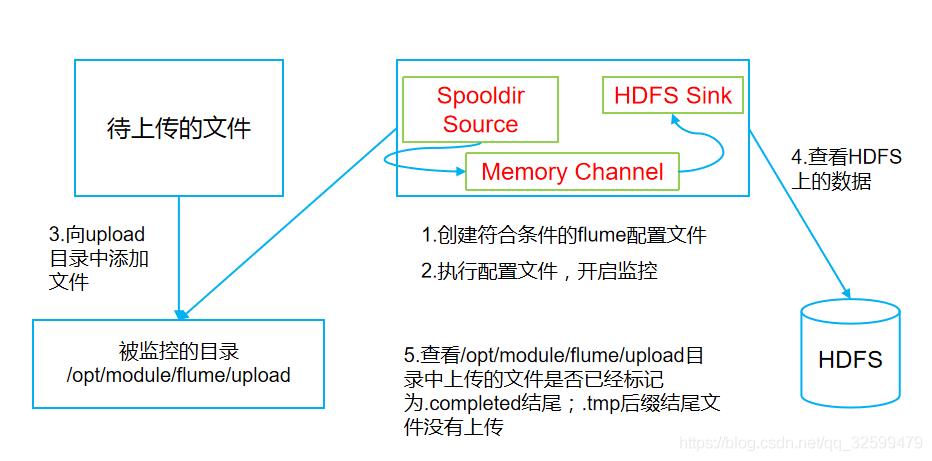
(1) 创建flume-dir-hdfs.conf文件
vim flume-dir-hdfs.conf
# 添加如下内容
a3.sources = r3
a3.sinks = k3
a3.channels = c3
# Describe/configure the source
a3.sources.r3.type = spooldir
a3.sources.r3.spoolDir = /opt/module/flume/upload
a3.sources.r3.fileSuffix = .COMPLETED
a3.sources.r3.fileHeader = true
#忽略所有以.tmp结尾的文件,不上传
a3.sources.r3.ignorePattern = ([^ ]*\\.tmp)
# Describe the sink
a3.sinks.k3.type = hdfs
a3.sinks.k3.hdfs.path = hdfs://hadoop102:9000/flume/upload/%Y%m%d/%H
#上传文件的前缀
a3.sinks.k3.hdfs.filePrefix = upload-
#是否按照时间滚动文件夹
a3.sinks.k3.hdfs.round = true
#多少时间单位创建一个新的文件夹
a3.sinks.k3.hdfs.roundValue = 1
#重新定义时间单位
a3.sinks.k3.hdfs.roundUnit = hour
#是否使用本地时间戳
a3.sinks.k3.hdfs.useLocalTimeStamp = true
#积攒多少个Event才flush到HDFS一次
a3.sinks.k3.hdfs.batchSize = 100
#设置文件类型,可支持压缩
a3.sinks.k3.hdfs.fileType = DataStream
#多久生成一个新的文件
a3.sinks.k3.hdfs.rollInterval = 60
#设置每个文件的滚动大小大概是128M
a3.sinks.k3.hdfs.rollSize = 134217700
#文件的滚动与Event数量无关
a3.sinks.k3.hdfs.rollCount = 0
# Use a channel which buffers events in memory
a3.channels.c3.type = memory
a3.channels.c3.capacity = 1000
a3.channels.c3.transactionCapacity = 100
# Bind the source and sink to the channel
a3.sources.r3.channels = c3
a3.sinks.k3.channel = c3(2) 启动flume-agent
bin/flume-ng agent -n a3 -c conf/ -f job/flume-dir-hdfs.conf(3) 开启另一个终端
cd /opt/module/flume/
mkdir upload
cp NOTICE upload/2.5 Flume案例-实时监控目录下的多个追加文件
Exec source适用于监控一个实时追加的文件,不能实现断电续传;Spooldir Source适合用于同步新文件,但不适合对实时追加日志的文件进行监听并同步;而Taildir Source适合用于监听多个实时追加的文件,并且能够实现断点续传。

(1) 创建flume-dir-hdfs.conf文件
vi flume-taildir-hdfs.conf
# 添加内容
a3.sources = r3
a3.sinks = k3
a3.channels = c3
# Describe/configure the source
a3.sources.r3.type = TAILDIR
a3.sources.r3.positionFile = /opt/module/flume/tail_dir.json
a3.sources.r3.filegroups = f1 f2
a3.sources.r3.filegroups.f1 = /opt/module/flume/files/.*file.*
a3.sources.r3.filegroups.f2 = /opt/module/flume/files/.*log.*
# 不能写成如下的形式,后面的会覆盖前面的
# a3.sources.r3.filegroups.f1 = /opt/module/flume/files/file1.txt
# a3.sources.r3.filegroups.f1 = /opt/module/flume/files/file2.txt
# Describe the sink
a3.sinks.k3.type = hdfs
a3.sinks.k3.hdfs.path = hdfs://hadoop102:9000/flume/upload2/%Y%m%d/%H
#上传文件的前缀
a3.sinks.k3.hdfs.filePrefix = upload-
#是否按照时间滚动文件夹
a3.sinks.k3.hdfs.round = true
#多少时间单位创建一个新的文件夹
a3.sinks.k3.hdfs.roundValue = 1
#重新定义时间单位
a3.sinks.k3.hdfs.roundUnit = hour
#是否使用本地时间戳
a3.sinks.k3.hdfs.useLocalTimeStamp = true
#积攒多少个Event才flush到HDFS一次
a3.sinks.k3.hdfs.batchSize = 100
#设置文件类型,可支持压缩
a3.sinks.k3.hdfs.fileType = DataStream
#多久生成一个新的文件
a3.sinks.k3.hdfs.rollInterval = 60
#设置每个文件的滚动大小大概是128M
a3.sinks.k3.hdfs.rollSize = 134217700
#文件的滚动与Event数量无关
a3.sinks.k3.hdfs.rollCount = 0
# Use a channel which buffers events in memory
a3.channels.c3.type = memory
a3.channels.c3.capacity = 1000
a3.channels.c3.transactionCapacity = 100
# Bind the source and sink to the channel
a3.sources.r3.channels = c3
a3.sinks.k3.channel = c3(2) 创建目录和文件
cd /opt/module/flume
mkdir files
cp CHANGELOG files/CHANGELOG.log
cp LICENSE files/LICENSE.log(3) 启动flume-agent
bin/flume-ng agent -n a3 -c conf/ -f job/flume-taildir-hdfs.conf(4) 开启另一个终端
cd /opt/module/flume/files
vi CHANGELOG.log
# 添加如下内容
xxxxx
sssss
wwwww三、Flume的进阶
3.1 Flume事务
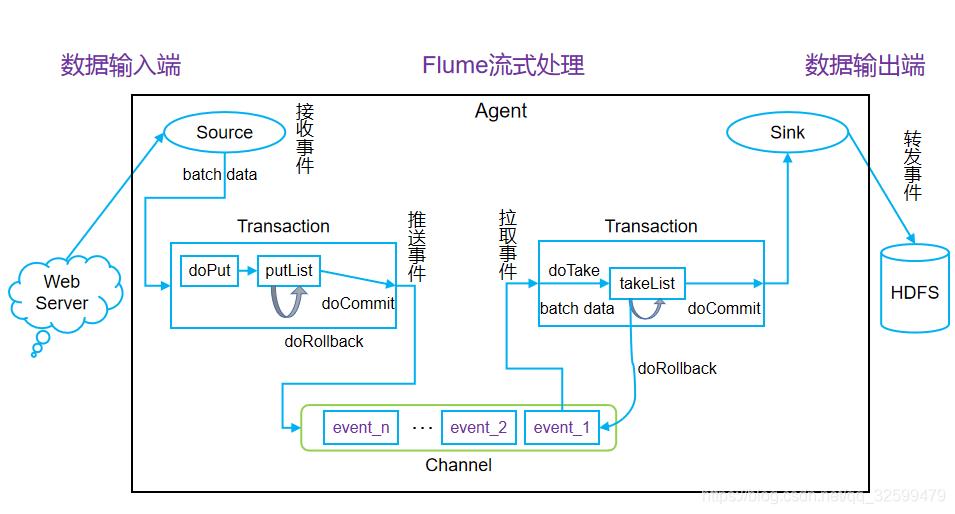
(1) Put事务流程
doPut:将批数据先写入临时缓存区putList
doCommit:检查channel内存队列是否足够合并
doRollback:channel内存队列空间不足,回滚数据
(2) Take事务流程
doTake:将数据取到临时缓存区takeList,并将数据发送到HDFS
doCommit:如果数据全部发送成功,则清除临时缓冲区takeList
doRollback:数据发送过程中如果出现异常,rollback将临时缓冲区takeList中的数据归还给channel内存队列
3.2 Flume Agent内部原理
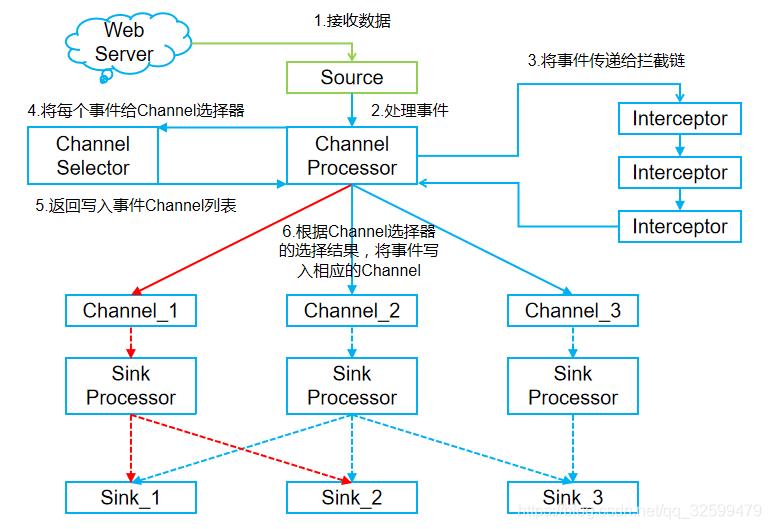
(1) ChannelSelector
ChannelSelector的作用就是选出Event将要被发往哪个Channel,其共有两种类型
Replicating(复制)
ReplicatingSelector会将同一个Event发往所有的Channel,
和Multiplexing(多路复用)
Multiplexing会根据相应的原则,将不同的Event发往不同的Channel
(2) SinkProcessor
SinkProcessor共有三种类型
DefaultSinkProcessor
对应单个sink,发送至单个sink
LoadBalancingSinkProcessor
LoadBalancingSinkProcessor对应的是Sink Group,LoadBalancingSinkProcessor可以实现负载均衡的功能
FailoverSinkProcessor
FailoverSinkProcessor对应的是Sink Group,
FailoverSinkProcessor可以错误恢复的功能
四、Flume的拓扑结构
4.1 简单串联

这种模式是将多个flume顺序连接起来了,从最初的source开始到最终sink传送的目的存储系统。
优点
多个flume并联,可以增加event缓存数量
缺点
此模式不建议桥接过多的flume数量, flume数量过多不仅会影响传输速率,而且一旦传输过程中某个节点flume宕机,会影响整个传输系统。
4.2 复制和多路复用

Flume支持将事件流向一个或者多个目的地。这种模式可以将相同数据复制到多个channel中,或者将不同数据分发到不同的channel中,sink可以选择传送到不同的目的地。
4.3 负载均衡和故障转移
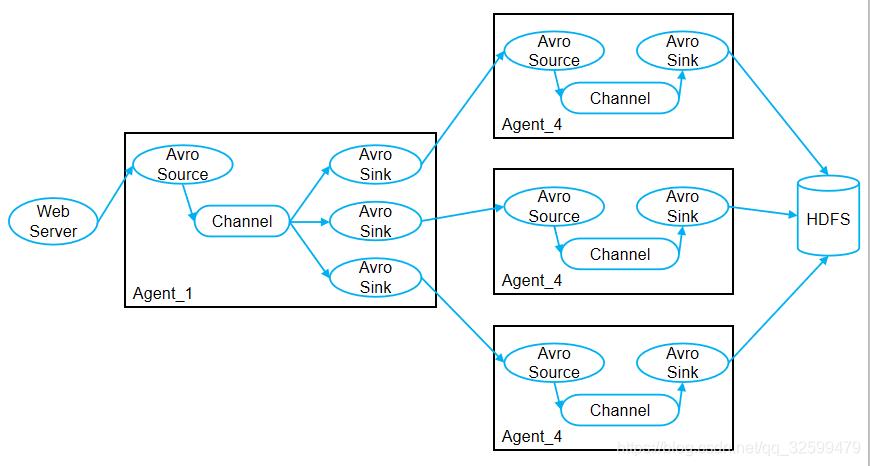
Flume支持使用将多个sink逻辑上分到一个sink组,sink组配合不同的SinkProcessor可以实现负载均衡和错误恢复的功能。
4.4 聚合

这种模式是我们最常见的,也非常实用,日常web应用通常分布在上百个服务器,大者甚至上千个、上万个服务器。产生的日志,处理起来也非常麻烦。用flume的这种组合方式能很好的解决这一问题,每台服务器部署一个flume采集日志,传送到一个集中收集日志的flume,再由此flume上传到hdfs、hive、hbase等,进行日志分析。
五、Flume的企业开发实例
5.1 复制和多路复用
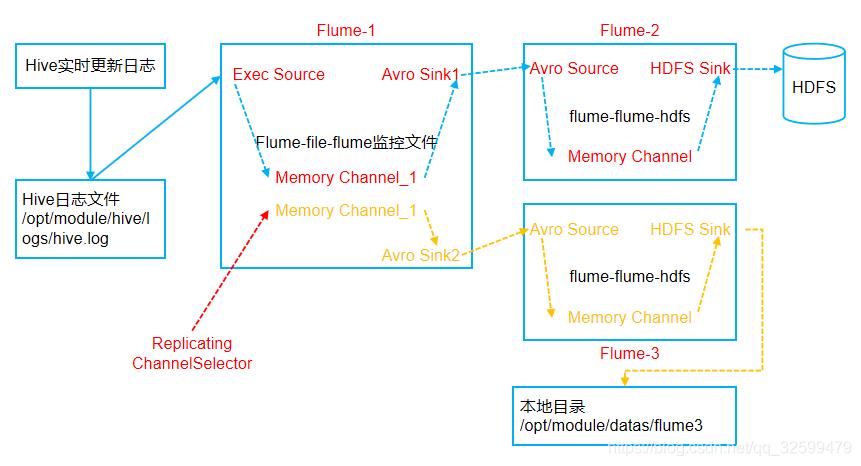
(1) 创建flume-file-avro.conf文件
vi flume-file-avro.conf
# Name the components on this agent
a1.sources = r1
a1.sinks = k1 k2
a1.channels = c1 c2
# 将数据流复制给所有channel
a1.sources.r1.selector.type = replicating
# Describe/configure the source
a1.sources.r1.type = exec
a1.sources.r1.command = tail -F /opt/module/hive/logs/hive.log
a1.sources.r1.shell = /bin/bash -c
# Describe the sink
# sink端的avro是一个数据发送者
a1.sinks.k1.type = avro
a1.sinks.k1.hostname = hadoop1021
a1.sinks.k1.port = 4141
a1.sinks.k2.type = avro
a1.sinks.k2.hostname = hadoop101
a1.sinks.k2.port = 4142
# Describe the channel
a1.channels.c1.type = memory
a1.channels.c1.capacity = 1000
a1.channels.c1.transactionCapacity = 100
a1.channels.c2.type = memory
a1.channels.c2.capacity = 1000
a1.channels.c2.transactionCapacity = 100
# Bind the source and sink to the channel
a1.sources.r1.channels = c1 c2
a1.sinks.k1.channel = c1
a1.sinks.k2.channel = c2(2) 创建flume-avro-hdfs.conf文件
vi flume-avro-hdfs.conf
# Name the components on this agent
a2.sources = r1
a2.sinks = k1
a2.channels = c1
# Describe/configure the source
# source端的avro是一个数据接收服务
a2.sources.r1.type = avro
a2.sources.r1.bind = hadoop101
a2.sources.r1.port = 4141
# Describe the sink
a2.sinks.k1.type = hdfs
a2.sinks.k1.hdfs.path = hdfs://hadoop102:9000/flume2/%Y%m%d/%H
#上传文件的前缀
a2.sinks.k1.hdfs.filePrefix = flume2-
#是否按照时间滚动文件夹
a2.sinks.k1.hdfs.round = true
#多少时间单位创建一个新的文件夹
a2.sinks.k1.hdfs.roundValue = 1
#重新定义时间单位
a2.sinks.k1.hdfs.roundUnit = hour
#是否使用本地时间戳
a2.sinks.k1.hdfs.useLocalTimeStamp = true
#积攒多少个Event才flush到HDFS一次
a2.sinks.k1.hdfs.batchSize = 100
#设置文件类型,可支持压缩
a2.sinks.k1.hdfs.fileType = DataStream
#多久生成一个新的文件
a2.sinks.k1.hdfs.rollInterval = 600
#设置每个文件的滚动大小大概是128M
a2.sinks.k1.hdfs.rollSize = 134217700
#文件的滚动与Event数量无关
a2.sinks.k1.hdfs.rollCount = 0
# Describe the channel
a2.channels.c1.type = memory
a2.channels.c1.capacity = 1000
a2.channels.c1.transactionCapacity = 100
# Bind the source and sink to the channel
a2.sources.r1.channels = c1
a2.sinks.k1.channel = c1(3) 创建flume-avro-dir.conf文件
vi flume-avro-dir.conf
# Name the components on this agent
a3.sources = r1
a3.sinks = k1
a3.channels = c2
# Describe/configure the source
a3.sources.r1.type = avro
a3.sources.r1.bind = hadoop101
a3.sources.r1.port = 4142
# Describe the sink
a3.sinks.k1.type = file_roll
a3.sinks.k1.sink.directory = /opt/module/flume/data/flume3
# Describe the channel
a3.channels.c2.type = memory
a3.channels.c2.capacity = 1000
a3.channels.c2.transactionCapacity = 100
# Bind the source and sink to the channel
a3.sources.r1.channels = c2
a3.sinks.k1.channel = c2(4) 执行配置文件
bin/flume-ng agent -n a3 -c conf/ -f job/group1/flume-avro-dir.conf
bin/flume-ng agent -n a2 -c conf/ -f job/group1/flume-avro-hdfs.conf
bin/flume-ng agent -n a1 -c conf/ -f job/group1/flume-file-avro.conf(5) 启动Hadoop和Hive
sbin/start-dfs.sh
sbin/start-yarn.sh
bin/hive5.2 故障转移

(1) 创建a1.conf文件
vi a1.conf
# Name the components on this agent
a1.sources = r1
a1.channels = c1
a1.sinks = k1 k2
# Describe/configure the source
a1.sources.r1.type = netcat
a1.sources.r1.bind = localhost
a1.sources.r1.port = 44444
a1.sinkgroups = g1
a1.sinkgroups.g1.sinks = k1 k2
a1.sinkgroups.g1.processor.type = failover
a1.sinkgroups.g1.processor.priority.k1 = 5
a1.sinkgroups.g1.processor.priority.k2 = 10
a1.sinkgroups.g1.processor.maxpenalty = 10000
# Describe the sink
a1.sinks.k1.type = avro
a1.sinks.k1.hostname = hadoop101
a1.sinks.k1.port = 4141
a1.sinks.k2.type = avro
a1.sinks.k2.hostname = hadoop101
a1.sinks.k2.port = 4142
# Describe the channel
a1.channels.c1.type = memory
a1.channels.c1.capacity = 1000
a1.channels.c1.transactionCapacity = 100
# Bind the source and sink to the channel
a1.sources.r1.channels = c1
a1.sinks.k1.channel = c1
a1.sinks.k2.channel = c1(2) 创建a2.conf文件
vi a2.conf
# Name the components on this agent
a2.sources = r1
a2.sinks = k1
a2.channels = c1
# Describe/configure the source
a2.sources.r1.type = avro
a2.sources.r1.bind = hadoop101
a2.sources.r1.port = 4141
# Describe the sink
a2.sinks.k1.type = logger
# Describe the channel
a2.channels.c1.type = memory
a2.channels.c1.capacity = 1000
a2.channels.c1.transactionCapacity = 100
# Bind the source and sink to the channel
a2.sources.r1.channels = c1
a2.sinks.k1.channel = c1(3) 创建a3.conf文件
vi a3.conf
# Name the components on this agent
a3.sources = r1
a3.sinks = k1
a3.channels = c2
# Describe/configure the source
a3.sources.r1.type = avro
a3.sources.r1.bind = hadoop101
a3.sources.r1.port = 4142
# Describe the sink
a3.sinks.k1.type = logger
# Describe the channel
a3.channels.c2.type = memory
a3.channels.c2.capacity = 1000
a3.channels.c2.transactionCapacity = 100
# Bind the source and sink to the channel
a3.sources.r1.channels = c2
a3.sinks.k1.channel = c2(4) 执行配置文件
bin/flume-ng agent -n a3 -c conf/ -f job/group2/a3.conf -Dflume.root.logger=INFO,console
bin/flume-ng agent -n a2 -c conf/ -f job/group2/a2.conf -Dflume.root.logger=INFO,console
bin/flume-ng agent -n a1 -c conf/ -f job/group2/a1.conf(5) 开启另一个终端,发送消息
nc localhost 4444
aaa(6) 杀死a3后,通过故障转移,a2能正常工作
kill -9 a3-pid5.3 负载均衡

(1) 创建a1.conf文件
vi a1.conf
# Name the components on this agent
a1.sources = r1
a1.channels = c1
a1.sinks = k1 k2
# Describe/configure the source
a1.sources.r1.type = netcat
a1.sources.r1.bind = localhost
a1.sources.r1.port = 44444
a1.sinkgroups = g1
a1.sinkgroups.g1.sinks = k1 k2
a1.sinkgroups.g1.processor.type = load_balance
a1.sinkgroups.g1.processor.backoff = true
a1.sinkgroups.g1.processor.selector = random
# Describe the sink
a1.sinks.k1.type = avro
a1.sinks.k1.hostname = hadoop101
a1.sinks.k1.port = 4141
a1.sinks.k2.type = avro
a1.sinks.k2.hostname = hadoop101
a1.sinks.k2.port = 4142
# Describe the channel
a1.channels.c1.type = memory
a1.channels.c1.capacity = 1000
a1.channels.c1.transactionCapacity = 100
# Bind the source and sink to the channel
a1.sources.r1.channels = c1
a1.sinks.k1.channel = c1
a1.sinks.k2.channel = c1(2) 创建a2.conf文件
vi a2.conf
# Name the components on this agent
a2.sources = r1
a2.sinks = k1
a2.channels = c1
# Describe/configure the source
a2.sources.r1.type = avro
a2.sources.r1.bind = hadoop101
a2.sources.r1.port = 4141
# Describe the sink
a2.sinks.k1.type = logger
# Describe the channel
a2.channels.c1.type = memory
a2.channels.c1.capacity = 1000
a2.channels.c1.transactionCapacity = 100
# Bind the source and sink to the channel
a2.sources.r1.channels = c1
a2.sinks.k1.channel = c1(3) 创建a3.conf文件
vi a3.conf
# Name the components on this agent
a3.sources = r1
a3.sinks = k1
a3.channels = c2
# Describe/configure the source
a3.sources.r1.type = avro
a3.sources.r1.bind = hadoop101
a3.sources.r1.port = 4142
# Describe the sink
a3.sinks.k1.type = logger
# Describe the channel
a3.channels.c2.type = memory
a3.channels.c2.capacity = 1000
a3.channels.c2.transactionCapacity = 100
# Bind the source and sink to the channel
a3.sources.r1.channels = c2
a3.sinks.k1.channel = c2(4) 执行配置文件
bin/flume-ng agent -n a3 -c conf/ -f job/group2/a3.conf -Dflume.root.logger=INFO,console
bin/flume-ng agent -n a2 -c conf/ -f job/group2/a2.conf -Dflume.root.logger=INFO,console
bin/flume-ng agent -n a1 -c conf/ -f job/group2/a1.conf(5) 开启另一个终端,不断发送消息
nc localhost 4444
aaa5.4 聚合

(1) 创建a1.conf文件
vi a1.conf
# Name the components on this agent
a1.sources = r1
a1.sinks = k1
a1.channels = c1
# Describe/configure the source
a1.sources.r1.type = exec
a1.sources.r1.command = tail -F /opt/module/flume/group.log
a1.sources.r1.shell = /bin/bash -c
# Describe the sink
a1.sinks.k1.type = avro
a1.sinks.k1.hostname = hadoop103
a1.sinks.k1.port = 4141
# Describe the channel
a1.channels.c1.type = memory
a1.channels.c1.capacity = 1000
a1.channels.c1.transactionCapacity = 100
# Bind the source and sink to the channel
a1.sources.r1.channels = c1
a1.sinks.k1.channel = c1(2) 创建a2.conf文件
vi a2.conf
# Name the components on this agent
a2.sources = r1
a2.sinks = k1
a2.channels = c1
# Describe/configure the source
a2.sources.r1.type = netcat
a2.sources.r1.bind = hadoop102
a2.sources.r1.port = 44444
# Describe the sink
a2.sinks.k1.type = avro
a2.sinks.k1.hostname = hadoop103
a2.sinks.k1.port = 4141
# Use a channel which buffers events in memory
a2.channels.c1.type = memory
a2.channels.c1.capacity = 1000
a2.channels.c1.transactionCapacity = 100
# Bind the source and sink to the channel
a2.sources.r1.channels = c1
a2.sinks.k1.channel = c1(3) 创建a3.conf文件
vi a3.conf
# Name the components on this agent
a3.sources = r1
a3.sinks = k1
a3.channels = c1
# Describe/configure the source
a3.sources.r1.type = avro
a3.sources.r1.bind = hadoop103
a3.sources.r1.port = 4141
# Describe the sink
# Describe the sink
a3.sinks.k1.type = logger
# Describe the channel
a3.channels.c1.type = memory
a3.channels.c1.capacity = 1000
a3.channels.c1.transactionCapacity = 100
# Bind the source and sink to the channel
a3.sources.r1.channels = c1
a3.sinks.k1.channel = c1(4) 执行配置文件
hadoop103
bin/flume-ng agent --conf conf/ --name a3 --conf-file job/group4/a3.conf -Dflume.root.logger=INFO,consolehadoop102
bin/flume-ng agent --conf conf/ --name a2 --conf-file job/group4/a2.confhadoop101
bin/flume-ng agent --conf conf/ --name a1 --conf-file job/group4/a1.conf(5) 开启另一个终端,不断发送消息
hadoop101
nc hadoop102 44444
aaa(6) 向group.log文件中,添加内容
hadoop101
cd /opt/module/flume
echo 222 >> group.log5.5 自定义Interceptor案例
根据日志不同的类型(type),将日志进行分流,分入到不同的sink
(1) 实现一个Interceptor接口
package com.inspur.flume.interceptor;
import org.apache.flume.Context;
import org.apache.flume.Event;
import org.apache.flume.interceptor.Interceptor;
import java.util.List;
import java.util.Map;
public class MyInterceptor implements Interceptor {
public void initialize() {
}
public Event intercept(Event event) {
Map<String, String> headers = event.getHeaders();
byte[] body = event.getBody();
if (body[0] <= '9' && body[0] >= '0') {
headers.put("type", "number");
} else {
headers.put("type", "not_number");
}
return event;
}
public List<Event> intercept(List<Event> events) {
for (Event event : events) {
intercept(event);
}
return events;
}
public void close() {
}
public static class MyBuilder implements Interceptor.Builder{
public Interceptor build() {
return new MyInterceptor();
}
public void configure(Context context) {
}
}
}(2) hadoop101创建配置文件a1.conf
hadoop101
cd /opt/module/flume/job/interceptor
vi a1.conf
# Name the components on this agent
a1.sources = r1
a1.sinks = k1 k2
a1.channels = c1 c2
# Describe/configure the source
a1.sources.r1.type = netcat
a1.sources.r1.bind = localhost
a1.sources.r1.port = 44444
a1.sources.r1.interceptors = i1
a1.sources.r1.interceptors.i1.type = com.inspur.flume.interceptor.MyInterceptor$MyBuilder
a1.sources.r1.selector.type = multiplexing
a1.sources.r1.selector.header = type
a1.sources.r1.selector.mapping.not_number = c1
a1.sources.r1.selector.mapping.number = c2
# Describe the sink
a1.sinks.k1.type = avro
a1.sinks.k1.hostname = hadoop102
a1.sinks.k1.port = 4141
a1.sinks.k2.type=avro
a1.sinks.k2.hostname = hadoop103
a1.sinks.k2.port = 4242
# Use a channel which buffers events in memory
a1.channels.c1.type = memory
a1.channels.c1.capacity = 1000
a1.channels.c1.transactionCapacity = 100
# Use a channel which buffers events in memory
a1.channels.c2.type = memory
a1.channels.c2.capacity = 1000
a1.channels.c2.transactionCapacity = 100
# Bind the source and sink to the channel
a1.sources.r1.channels = c1 c2
a1.sinks.k1.channel = c1
a1.sinks.k2.channel = c2(3) hadoop102创建配置文件a1.conf
hadoop102
cd /opt/module/flume/job/interceptor
vi a1.conf
# Name the components on this agent
a1.sources = r1
a1.sinks = k1
a1.channels = c1
a1.sources.r1.type = avro
a1.sources.r1.bind = hadoop102
a1.sources.r1.port = 4141
a1.sinks.k1.type = logger
a1.channels.c1.type = memory
a1.channels.c1.capacity = 1000
a1.channels.c1.transactionCapacity = 100
a1.sinks.k1.channel = c1
a1.sources.r1.channels = c1(4) hadoop103创建配置文件a1.conf
hadoop103
cd /opt/module/flume/job/interceptor
vi a1.conf
# Name the components on this agent
a1.sources = r1
a1.sinks = k1
a1.channels = c1
a1.sources.r1.type = avro
a1.sources.r1.bind = hadoop103
a1.sources.r1.port = 4242
a1.sinks.k1.type = logger
a1.channels.c1.type = memory
a1.channels.c1.capacity = 1000
a1.channels.c1.transactionCapacity = 100
a1.sinks.k1.channel = c1
a1.sources.r1.channels = c1(5) 分别启动flume进程
hadoop103
bin/flume-ng agent -n a1 -c conf/ -f job/interceptor/a1.conf -Dflume.root.logger=INFO,consolehadoop102
bin/flume-ng agent -n a1 -c conf/ -f job/interceptor/a1.conf -Dflume.root.logger=INFO,consolehadoop101
bin/flume-ng agent -n a1 -c conf/ -f job/interceptor/a1.conf -Dflume.root.logger=INFO,console(6) 开启另一个终端,不断发送消息
hadoop101
nc hadoop102 44444
aaa
111
1ss
s115.6 自定义Source案例
(1) 实现一个Source类
package com.inspur.flume.source;
import org.apache.flume.Context;
import org.apache.flume.Event;
import org.apache.flume.EventDeliveryException;
import org.apache.flume.PollableSource;
import org.apache.flume.conf.Configurable;
import org.apache.flume.event.SimpleEvent;
import org.apache.flume.source.AbstractSource;
import java.util.HashMap;
public class MySource extends AbstractSource implements Configurable, PollableSource {
private String prefix;
private long interval;
public Status process() throws EventDeliveryException {
Status status = null;
try {
for (int i = 1; i <= 5; i++) {
Event e = new SimpleEvent();
e.setHeaders(new HashMap<String, String>());
e.setBody((prefix + i).getBytes());
getChannelProcessor().processEvent(e);
Thread.sleep(interval);
}
status = Status.READY;
} catch (InterruptedException e) {
status = Status.BACKOFF;
}
return status;
}
public long getBackOffSleepIncrement() {
return 2000;
}
public long getMaxBackOffSleepInterval() {
return 20000;
}
public void configure(Context context) {
prefix = context.getString("source.prefix","Log");
interval = context.getLong("source.interval",1000L);
}
}(2) hadoop101创建配置文件a1.conf
hadoop101
cd /opt/module/flume/job/source
vi a1.conf
# Name the components on this agent
a1.sources = r1
a1.sinks = k1
a1.channels = c1
# Describe/configure the source
a1.sources.r1.type = com.inspur.flume.source.MySource
a1.sources.r1.source.prefix= Log
a1.sources.r1.source.interval= 1000
# Describe the sink
a1.sinks.k1.type = logger
# Use a channel which buffers events in memory
a1.channels.c1.type = memory
a1.channels.c1.capacity = 1000
a1.channels.c1.transactionCapacity = 100
# Bind the source and sink to the channel
a1.sources.r1.channels = c1
a1.sinks.k1.channel = c1(3) 启动flume进程
hadoop101
bin/flume-ng agent -n a1 -c conf/ -f job/source/a1.conf -Dflume.root.logger=INFO,console5.7 自定义文件Source案例二
(1) 实现一个Source类,接收MQTT服务器
引入org.eclipse.paho.client.mqttv3.* 类包
自定义一个Source类
自定义一个SimpleMqttClient类
该类用于配置MQTT服务器的链接(IP地址、端口号、用户名、密码、主题)、订阅主题消息、订阅消息的回调
接收到回调函数的消息,进行event的封装,然后发送
(2) 实现一个Source类,接收传感器串口数据
自定义一个Source类
自定义一个串口类
该类用于配置串口类的链接(串口号、波特率、校验位、数据位、停止位)、数据的回调(数据都是以十六进制进行传递)
接收到回调函数的消息,进行event的封装,然后发送
5.8 自定义Sink案例
(1) 实现一个Sink类
package com.inspur.flume.sink;
import org.apache.flume.*;
import org.apache.flume.conf.Configurable;
import org.apache.flume.sink.AbstractSink;
public class MySink extends AbstractSink implements Configurable {
private long interval;
private String prefix;
private String suffix;
public Status process() throws EventDeliveryException {
Status status = null;
Channel channel = this.getChannel();
Transaction transaction = channel.getTransaction();
transaction.begin();
try {
Event event = null;
while ((event = channel.take()) == null) {
Thread.sleep(interval);
}
byte[] body = event.getBody();
String line = new String(body, "UTF-8");
System.out.println(prefix + line + suffix);
status = Status.READY;
transaction.commit();
} catch (Exception e) {
transaction.rollback();
status = Status.BACKOFF;
} finally {
transaction.close();
}
return status;
}
public void configure(Context context) {
prefix = context.getString("source.prefix", "start:");
suffix = context.getString("source.suffix", ":end");
interval = context.getLong("source.interval", 1000L);
}
}(2) hadoop101创建配置文件a1.conf
hadoop101
# Name the components on this agent
a1.sources = r1
a1.sinks = k1
a1.channels = c1
# Describe/configure the source
a1.sources.r1.type = netcat
a1.sources.r1.bind = localhost
a1.sources.r1.port = 44444
# Describe the sink
a1.sinks.k1.type = com.inspur.flume.sink.MySink
a1.sinks.k1.source.prefix = xuzheng:
a1.sinks.k1.source.suffix = :xuzheng
a1.sinks.k1.source.interval = 1000
# Use a channel which buffers events in memory
a1.channels.c1.type = memory
a1.channels.c1.capacity = 1000
a1.channels.c1.transactionCapacity = 100
# Bind the source and sink to the channel
a1.sources.r1.channels = c1
a1.sinks.k1.channel = c1(3) 启动flume进程
hadoop101
bin/flume-ng agent -n a1 -c conf/ -f job/sink/a1.conf -Dflume.root.logger=INFO,console六、Flume数据流监控
6.1 Flume自带监控工具
执行如下的命令,并访问 http://IP:1234
bin/flume-ng agent -n a1 -c conf/ -f job/sink/a1.conf -Dflume.monitoring.type=http -Dflume.monitoring.port=12346.2 Ganglia
Ganglia由gmond、gmetad和gweb三部分组成
gmond(Ganglia Monitoring Daemon)
gmond是一种轻量级服务,安装在每台需要收集指标数据的节点主机上。使用gmond,你可以很容易收集很多系统指标数据,如CPU、内存、磁盘、网络和活跃进程的数据等
gmetad(Ganglia Meta Daemon)
gmetad整合所有信息,并将其以RRD格式存储至磁盘的服务
gweb(Ganglia Web)
Ganglia可视化工具,gweb是一种利用浏览器显示gmetad所存储数据的php前端。在Web界面中以图表方式展现集群的运行状态下收集的多种不同指标数据
6.3 Ganglia监控视图
EventPutSuccessCount = EventTakeSuccessCount + ChannelSize
否则,丢数据。
以上是关于一问搞懂Flume的主要内容,如果未能解决你的问题,请参考以下文章
flume到底会丢数据吗?其可靠性如何?——轻松搞懂Flume事务机制
Java -- 每日一问:有人说“Lambda能让Java程序慢30倍”,你怎么看?